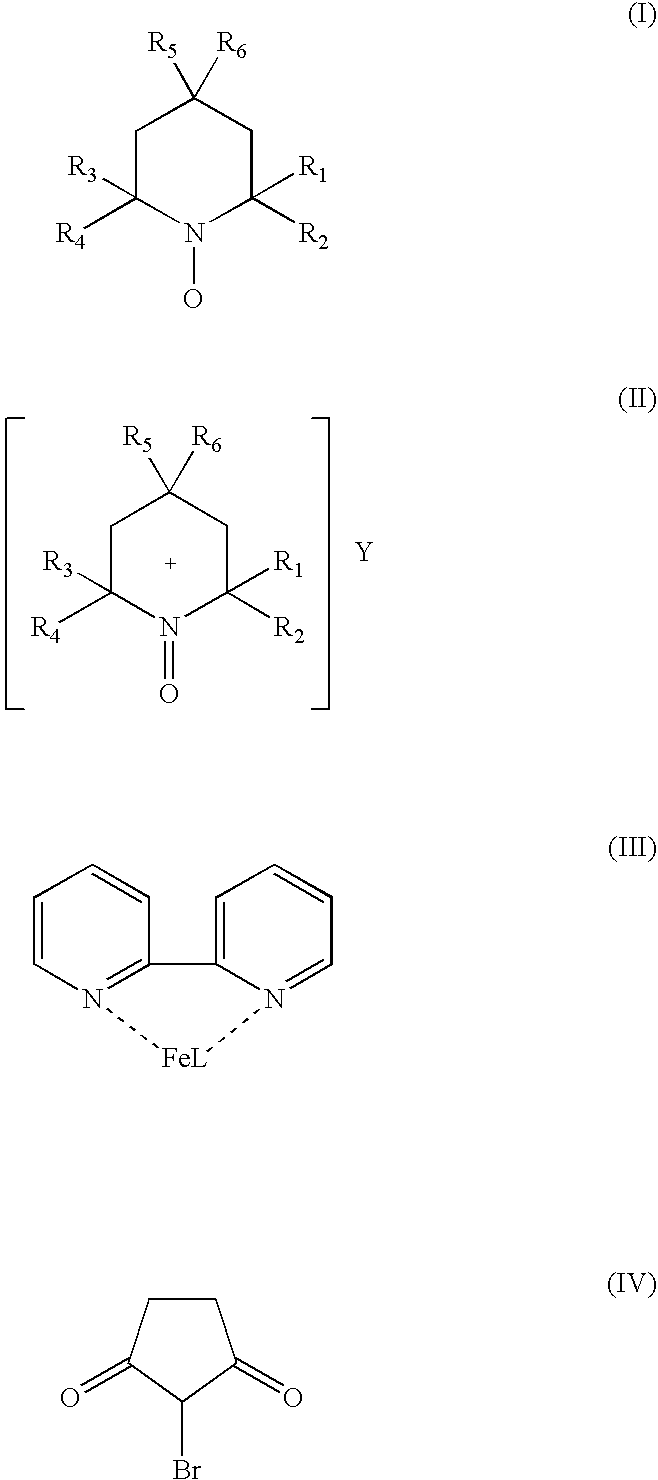Catalyst system for aerobic oxidation of primary and secondary alcohols
a catalyst system and alcohol technology, applied in the direction of carbonyl compound preparation by oxidation, organic compound/hydride/coordination complex catalyst, physical/chemical process catalyst, etc., can solve the problems of limited use of the described method, few efficient systems currently available, system being virtually inactiv
- Summary
- Abstract
- Description
- Claims
- Application Information
AI Technical Summary
Problems solved by technology
Method used
Image
Examples
example iii
[0034] Example III illustrates the oxidation of 3,3-dimethyl-1-butanol to 3,3-dimethyl-1-butanal using the catalyst system of the current invention:
[0035] 170 mg of Fe(NO3)3.9H2O (0.416 mmol), 66 mg 2,2′-bipyridyl (0.416 mmol), 85 mg TEMPO (0.536 mmol) and 80 mg N-bromosuccinimide (0.45 mmol) are dissolved in glacial acetic acid (7 cc) and the solution transferred into a jacketed glass reactor. The reactor is alternately evacuated and purged with oxygen at least five times and the temperature of the catalyst solution is raised to the target value of 45° C. under constant stirring of 1500 RPM. When the temperature reached 45° C., 8200 mg of 3,3-dimethyl-1-butanol (76.6 mmol) are injected through the septum adapter using a gas tight syringe. The recorded oxygen uptake rate is 0.205 mmol O2 / min and the GC analysis after 250 min reaction time showed 95.2% conversion of the starting alcohol and 96.2% selectivity to the desired 3,3-dimethyl-1-butanal. The graphical presentation of this r...
example iv
[0036] Example IV represents the potential of the catalyst composition to be used at even higher alcohol concentration in direct comparison with Example III.
[0037] 170 mg of Fe(NO3)30.9H2O (0.416 mmol), 66 mg 2,2′-bipyridyl (0.416 mmol), 85 mg TEMPO (0.536 mmol) and 80 mg N-bromosuccinimide (0.45 mmol) are dissolved in glacial acetic acid (7 cc) and the solution transferred into a jacketed glass reactor. The dissolution and thermostating of the catalyst solution is done as in Example III. When the temperature reached 45° C., 9840 mg of 3,3-dimethyl-1-butanol (91.9 mmol) are injected through the septum adapter using a gas tight syringe. The recorded oxygen uptake rate was 0.184 mmol O2 / min and the GC analysis after 420 min reaction time showed 89.2% conversion of the starting alcohol and 97.4% selectivity to the desired 3,3-dimethyl-1-butanal. The graphical presentation of this reaction is also shown in the same FIG. 01, curve 4, NS1027.
example v
[0038] Example V represents addition protocol in which the catalysts solution and the alcohol are charged in the reactor prior purging the reactor with oxygen and raising the temperature.
[0039] 170 mg of Fe(NO3)30.9H2O (0.416 mmol), 66 mg 2,2′-bipyridyl (0.416 mmol), 85 mg TEMPO (0.536 mmol), 80 mg N-bromosuccinimide (0.45 mmol) and 8200 mg of 3,3-Dimethyl-1-butanol (76.6 mmol) are dissolved in glacial acetic acid (7 cc) and the solution transferred into a jacketed glass reactor. The dissolution and thermostating of the catalyst solution is done as in Example III. When the temperature reached 45° C. the stirring rate was set to 1500 RPM and at this point, monitoring of the oxygen uptake was initiated. The recorded oxygen uptake rate was 0.220 mmol O2 / min and the GC analysis after 230 min reaction time showed 96.3% conversion of the starting alcohol and 98.5% selectivity to the desired 3,3-dimethyl-1-butanal. The graphical presentation of this reaction is also shown in the same FIG....
PUM
| Property | Measurement | Unit |
|---|---|---|
| mol % | aaaaa | aaaaa |
| reaction temperature | aaaaa | aaaaa |
| mol % | aaaaa | aaaaa |
Abstract
Description
Claims
Application Information
 Login to View More
Login to View More - R&D
- Intellectual Property
- Life Sciences
- Materials
- Tech Scout
- Unparalleled Data Quality
- Higher Quality Content
- 60% Fewer Hallucinations
Browse by: Latest US Patents, China's latest patents, Technical Efficacy Thesaurus, Application Domain, Technology Topic, Popular Technical Reports.
© 2025 PatSnap. All rights reserved.Legal|Privacy policy|Modern Slavery Act Transparency Statement|Sitemap|About US| Contact US: help@patsnap.com



